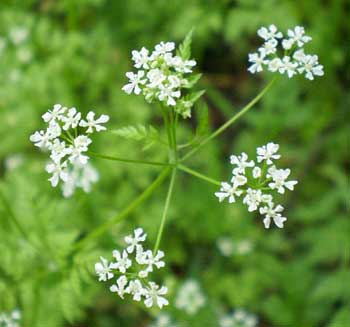Contents:
Common Names | Parts Usually Used | Plant(s) & Culture | Where Found | Medicinal Properties
Legends, Myths and Stories | Uses | Formulas or Dosages | How Sold | Warning | Bibliography
Scientific Names

- Anthriscus cerefolium L.
- Umbelliferae
- Umbel family
Common Names
- Cerefolium
- Gourmet’s parsley
- Mirrha
- Mirrhis
- Myrrhis
- Sweet chervil
Parts Usually Used
Flowering plant
Back to Top

Description of Plant(s) and Culture
Chervil is an annual plant; the round, finely grooved, branched stem grows 12-26 inches tall from a thin, whitish root. The leaves are opposite, light green, and bipinnate, the lower leaves petioled, the upper sessile on stem sheaths. The small, white flowers grow in compound umbels from May to July. The elongated, segmented seeds ripen in August and September.
The wild chervil grows 2-3 feet high with yellow stalks and joints, set with broader and more hairy leaves, divided into sundry parts, nicked about the edges and of a dark green color. Has little or no scent.
Back to Top
Where Found
Cultivated in many places as a kitchen spice. In southern Europe it flourishes in the wild; a native of Asia.
Back to Top
Medicinal Properties
Digestive, diuretic, expectorant, stimulant
Back to Top
Legends, Myths and Stories
Chervil has a delicate, subtle flavor with a slight hint of anise, but the flavor does not withstand long cooking.
Pliny claimed the boiled roots were used as a preventive against plague.
In Europe, chervil soup is eaten on Holy Thursday as a symbol of resurrection and a new life. Because its scent reminds of the fragrance of myrrh (one of the offerings at the birth of Christ), it is often called myrrhis.
The Romans planted chervil near their encampments and still grows in the vicinity of these ancient sites.
Back to Top
Uses
The juice that is pressed out of the flowers is used for scrofula, eczema, gout, abscesses, dropsy, and dysmenorrhea. The infusion of the plant is used in Europe to lower blood pressure. Helps indigestion, and is a blood thinner, as well as a diuretic and a tonic.
In the Middle Ages, the leaves were used to soothe the pain of rheumatism and bruises, swellings, as well as an anti-depressant; some still eat it today to cure the hiccups. Chervil is supposed to have great qualities of rejuvenation.
Back to Top
Formulas or Dosages
Infusion: use 1 sp. fresh or dried herb with 1/2 cup water. Take 1/2 to 1 cup a day, unsweetened, a mouthful at a time.
Back to Top
How Sold
Spice
Back to Top
Warning
The Umbelliferae family (Umbel family) of chervil is also the family of the poisonous members of the family, like the Hemlock. Beginners find it difficult to distinguish true chervil from its more ill-disposed cousins. Care should be taken to correctly identify chervil.
Back to Top
Bibliography
![]() Culpeper’s Complete Herbal & English Physician: Updated With 117 Modern Herbs
Culpeper’s Complete Herbal & English Physician: Updated With 117 Modern Herbs, by Nicholas Culpeper, Meyerbooks, publisher, PO Box 427, Glenwood, Illinois 60425, 1990, (reprint of 1814)
![]() The Herbalist Almanac
The Herbalist Almanac, by Clarence Meyer, Meyerbooks, publisher, PO Box 427, Glenwood, Illinois 60425, copyright 1988, fifth printing, 1994
![]() The Herb Book
The Herb Book, by John Lust, Bantam Books, 666 Fifth Avenue, New York, NY. copyright 1974.
Herbal Gardening, compiled by The Robison York State Herb Garden, Cornell Plantations, Matthaei Botanical Gardens of the University of Michigan, University of California Botanical Garden, Berkeley., Pantheon Books, Knopf Publishing Group, New York, 1994, first edition
 The Magic of Herbs
The Magic of Herbs, by David Conway, published by Jonathan Cape, Thirty Bedford Square, London, England. (Out of print)
![]() The Nature Doctor: A Manual of Traditional and Complementary Medicine
The Nature Doctor: A Manual of Traditional and Complementary Medicine, by Dr. H.C.A. Vogel; Keats Publishing, Inc., 27 Pine Street (Box 876) New Canaan, CT. 06840-0876. Copyright Verlag A. Vogel, Teufen (AR) Switzerland 1952, 1991
![]() Webster’s New World Dictionary
Webster’s New World Dictionary, Third College Edition, Victoria Neufeldt, Editor in Chief, New World Dictionaries: A Division of Simon & Schuster, Inc., 15 Columbus Circle, New York, NY 10023
 The Rodale Herb Book: How to Use, Grow, and Buy Nature’s Miracle Plants (An Organic gardening and farming book)
The Rodale Herb Book: How to Use, Grow, and Buy Nature’s Miracle Plants (An Organic gardening and farming book), edited by William H. Hylton, Rodale Press, Inc. Emmaus, PA, 18049., 1974
